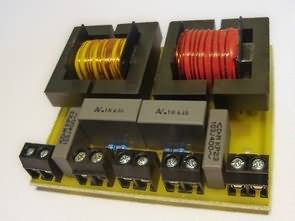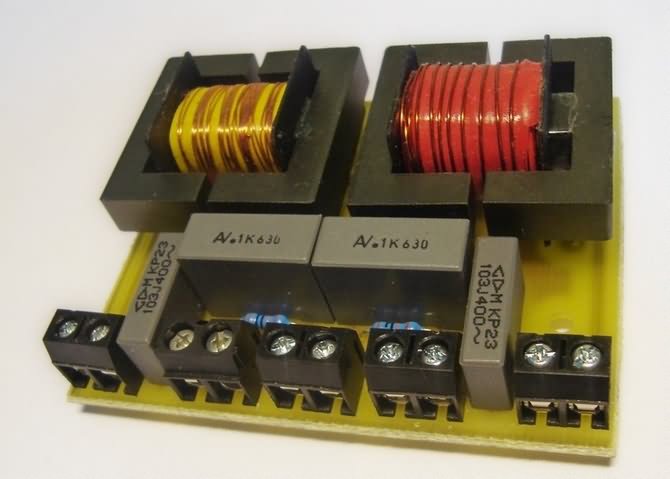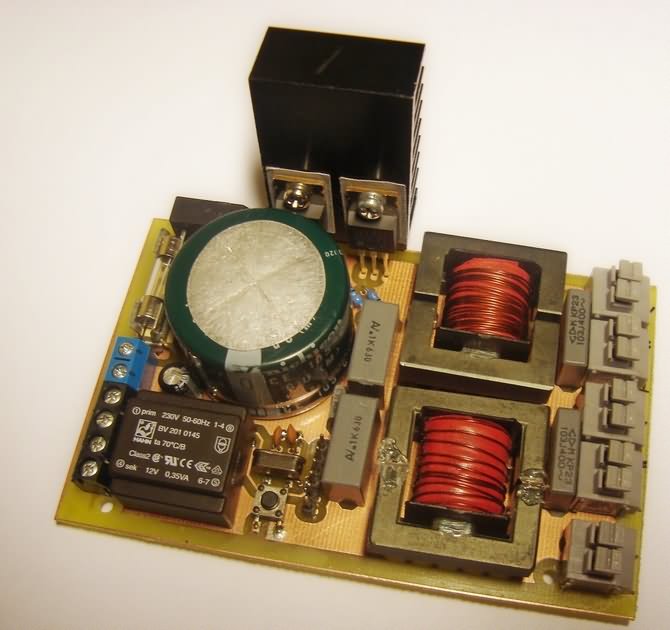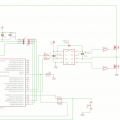
IR2104 240W Fluorescent tube Ballast Circuit. Work was designed an electronic ballast for starting six fluorescent lamps with a total output of 240W with integrated dimming-controlled analog input and button. Priority is set to control voltage. If the input voltage less than 0.5 V, tests with the push of a button. Measuring the voltage at the input is constant, and when voltage detection is higher than 0.5 V, occurs to the start of the fluorescent lamps and the subsequent setting of the intensity of the brightness-dependent the inlet voltage, while when 5 V is set to the maximum intensity. When the control voltage it was necessary to introduce hysteresis due to the constant changing frequency. This hysteresis has been set step ±50 Hz. The resolution of the transfer of voltage to frequency is therefore in the set range of 80 steps.
Electronic Fluorescent Balast Circuit Schematic
Button can change the intensity of the brightness smoothly from the maximum after the minimum and back. In short pressing leads to switching on/switching off fluorescent lamps. When the measurement has been adjusted value of the inductor, 1.6 mH and ignition/operating frequency was set to 48 kHz. At this value the voltage at the fluorescent lamp was 104 In. The maximum frequency when the fluorescent lamp still shone was 62 kHz. The wiring is designed with a microcontroller ATmega48 and an integrated circuit of the IR2104

For sorting of fluorescent lamps has been chosen parallel arrangement mainly due to the power options directly from the mains 230 V/50Hz without the need to use increasing source of tension. Another advantage of this involvement is also the choice of the number of tubes from 1 pc to 6 pcs. The control program is written so that you can simply change the frequency stored in the variable zhav, light, max, and min. All the necessary calculations for the oscillator and the AD converter are contained in the program code and for the calculation of the required frequencies, the capacitor and inductors can be use conveniently program Ballast Designer V4 from the company International Rectifier.

![]() IR2104 Ballast Circuit pcb schematic ATmega48 source code all files alternative links:
IR2104 Ballast Circuit pcb schematic ATmega48 source code all files alternative links:
FILE DOWNLOAD LINK LIST (in TXT format): LINKS-25707.zip
Published: 2016/06/19 Tags: avr project, microcontroller projects, power electronic projects

RMS 2X200W Amplifier Circuit MJL21196 MJL21195
2X200W transistor amplifier circuit The aim of this bachelor thesis was to design a low frequency power amplifier for speakers for the purpose of sound public events. Its use therefore determine addressed the concerns of the processing, where required by the supply of sufficient power (at least 200W per channel into a load of 4Ω) for four odposluchy serving musicians, DJ, bands, singers and others. His proposal demanded high-quality processing, as the custom filing sound for the musician it must be sufficiently loyal and quality, so that it could assess whether to improve. This work addresses the complete involvement of of the amplifier and thus contains the analysis of the individual blocks as they are the ac power source, the preamplifier, the amplifier stages but also the module spds speakers and amplifier.
240W Elektronische Vorschaltgerät Schaltung IR2104 ATmega48 Gesteuert
IR2104-240W Leuchtstoffröhre Vorschaltgerät-Schaltung. Arbeit wurde ein elektronisches Vorschaltgerät zum starten sechs Leuchtstofflampen mit einer Gesamtleistung von 240W mit integrierter DIMM-gesteuerten analog-input und button. Priorität gesetzt ist, zum Steuern der Spannung. Wenn die Eingangsspannung weniger als 0,5 V, die tests mit dem Knopfdruck. Mess die Spannung am Eingang konstant ist, und bei Detektion der Spannung höher als 0,5 V ist, tritt zu Beginn der Leuchtstofflampen und der anschließenden Einstellung der Intensität der Helligkeit abhängig der Einlass-Spannung, während die bei 5 V ist die maximale Intensität. Wenn die Steuerspannung war es notwendig, einzuführen, Hysterese aufgrund der sich ständig ändernden Frequenz. Diese Hysterese eingestellt wurde Schritt ±50 Hz. Die Auflösung der übertragung von Spannung zu Frequenz ist daher in den set-Bereich von 80 Schritte.